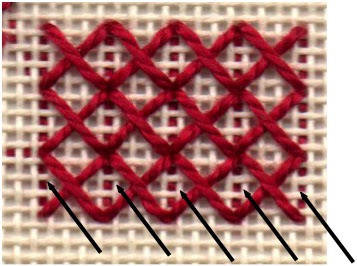I started stitching today, filling in an irregular shape with a composite stitch. Here is my irregular shape:
 |
| Line Drawing of Shape to Fill |
 |
| Composite Stitch |
 |
| Upright Cross Stitch Plaited Cross Stitch |
Here is a diagram of the entire composite stitch pattern:
 |
| Composite Stitch Pattern |
Many times when stitching composite stitches, the stitcher chooses to stitch all of the first stitch to fill the area as Step 1. Then as Step 2, complete the stitch by stitching all of the second stitch over those stitches of Step 1. Here is how Step 1 would be diagrammed:
 |
| Step 1. Upright Cross Stitch |
Then for Step 2, stitch the plaited cross stitch over the top of the upright cross stitches:
 |
| Step 2. Adding Plaited Cross Stitches over the top of the Upright Cross Stitches |
I’m thinking - no problem, this should not be hard to compensate.
So I start filling the area with the first stitch, the upright cross stitch. Here is my stitching so far - an easy stitch to compensate.
 |
| Step 1. Stitched Area |
Now I start to overstitch that first part with the plaited cross stitch, I know how to compensate this one too, so I am not concerned.
Until I get here:
 |
| Arrow Points to Compensation Problem |
Now I have a dilemma. This next stitch needs to go through the canvas hole where the arrow is pointing but the metallic braid from Step 1 lies across it, as well as the red thread from Step 2.
Well, that creates quite a problem. I have stitched the whole upright cross (blue) stitch section already, and to take out that one stitch is going to cause me to take out many more stitches. I have a choice here:
- Go ahead and stitch around or through the threads that cover that hole in the canvas. Not really a good choice, it will distort that stitch and make it look not quite right.
- Take out a few of those upright cross (blue) stitches and fix the mistake. And my mistake was to only think about the compensation of the upright cross (blue) stitches when I needed to think of the compensation of both the upright cross (blue) stitches and the plaited cross (red) stitches simultaneously. Sigh . . .
OK, I did not plan well.
Plan Ahead!
Here is how to approach this type of a stitching situation prior to actually starting to stitch:
- Recognize that compensation is necessary. If this is a composite stitch, any one of the stitches, or all of the stitches that make up the composite stitch, may need to be compensated. And any of those compensated stitches may affect any of the other stitches in the composite stitch.
- Either
- Use two needles simultaneously and stitch as much of a line of stitches that will not be compensated in the Step 1 all upright cross (blue) stitches, then Step 2 all plaited cross (red) stitches method. At any area that needs to be compensated, stitch each composite stitch with all of the compensation needed in its entirety before moving onto the next composite stitch. Here is what I mean for this example:
Stitch first and second row by stitching upright cross stitches (blue) stitches first then
the plaited stitches (red) stitches. No compensation in the first two rows (I am ignoring
the left side edge for this example).
At row three, the first compensated stitch that will cause a problem is here. Stitch
upright cross (blue) stitch, compensate it for the size of the area to be stitched and note
where the plaited cross (red) stitch is going to have to be compensated. That means you
will have to divide the horizontal portion of that upright cross (blue) stitch into two stitches.
Stop.
%2Bstep%2B1.jpg) |
| Diagram of Step 1 of Compensation in Row 3 |
Now stitch the plaited cross (red) stitch, compensating it.
With this method, you will stitch at most one upright cross (blue) stitch before you
realize that the plaited cross (red) stitch has to be compensated, and the upright cross
(blue) stitch interferes with the compensation of the plaited cross (red) stitch. Therefore
you will only need to unstitch the upright cross (blue) stitch to resolve this compensation
issue. If no more compensation is needed you can go back to the Step 1 stitch all upright
cross (blue) stitches followed by Step 2 all plaited cross (red) stitches until you reach thenext composite stitch that needs to be compensated.

















